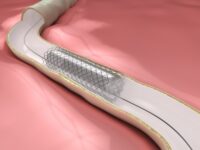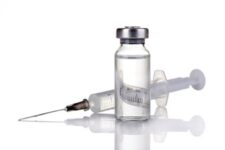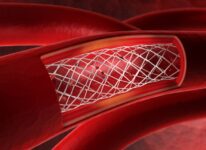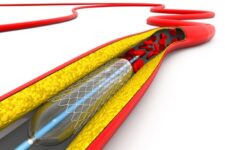Original title: Frecuency domain optical coherente tomography to assess non-ostial left main artery. Reference: Francesco Burzotta, et al. EuroIntervention 2015;10e1-e8 Optical coherence tomography (OCT) has proved valuable in making decisions and monitoring stents implanted in coronary arteries, but its role in the assessment of left main (LM) lesions remains unclear. The study included 54 patients presenting moderate…
Pretreatment with clopidogrel only for ST elevation AMI patients
Original title: Prognostic impact of clopidogrel pretreatment in patients with acute coronary syndrome managed invasively. Reference: Almendro-Delia M et al. Am J Cardiol. 2015; Epub ahead of print. This study analyzed the ARIAM data including 9621 AMI patients diagnosed with coronary angiography receiving clopidogrel in 49 center between 2002 and 2012. Most patients had STEMI (63%), and most…
Safety and efficacy of DES in saphenous vein bypass graft PCI
Original title: Safety and effectiveness of drug-eluting versus bare-metal stents in saphenous vein bypass graft percutaneous coronary interventions: insights from the Veterans Affairs CART program. Reference: Aggarwal V et al. J Am Coll Cardiol. 2014;64:1825-1836. This study retrospectively evaluated 2471 receiving after saphenous vein graft (SVG) PCI between October and September 2011. Outcomes were compared using propensity…
Net clinical benefit of bivalirudin in STEMI patients
Original title: Bivalirudin Versus Heparin With or Without Glycoprotein IIb/IIIa Inhibitors in Patients With STEMI Undergoing Primary Percutaneous Coronary Intervention: Pooled Patient-Level Analysis From the HORIZONS-AMI and EUROMAX Trials. Reference: Stone GW et al. J Am CollCardiol. 2015 Jan 6;65(1):27-38. The HORIZONS-AMI (Harmonizing Outcomes with RevasculariZatiON and Stents in Acute Myocardial Infarction) that included 3602 STEMI patients undergoing…
Results of the new repositionable and retrievable percutaneous valve system
Original title: Transcatheter Aortic Valve Replacement for Severe Symptomatic Aortic Stenosis Using a Repositionable Valve System. 30-Day Primary Endpoint Results From the REPRISE II Study. Reference: Ian T. Meredith AM et al. J Am Coll Cardiol 2014;64:1339–48. Transcatheter aortic valve replacement (TAVR) showed results comparable to those of surgery in patients at high surgical risk, but complications can…
Percutaneous treatment of aortic coarctation with self-expandable uncovered nitinol stent
Original title: Percutaneous treatment of adult isthmic aortic coarctation: acute and long-term clinical and imaging outcome with a self-expandable uncovered nitinol stent. Reference: Kische S et al. Circ Cardiovasc Interv. 2015 Jan;8(1). The aim of this study was to show perioperative and long term results of the percutaneous treatment of aortic coarctation with the self-expandable uncovered nitinol…
Tomography vs FFR to identify lesions that cause ischemia
Original title: Atherosclerotic Plaque Characteristics by CT Angiography Identify Coronary Lesions That Cause IschemiaA Direct Comparison to Fractional Flow Reserve. Reference: Hyung-Bok Park et al. J Am CollCardiolImg. 2015;8(1):1-10. This trial evaluated the characteristics of arteriosclerotic plaques and its association with lesion ischemia by CT angiography (CTA) vs fractional flow reserve (FFR). FFR is the gold standard to…
Frequency, indication and evolution of emergency cardiac surgery during TAVI
Original Title: Emergent cardiac surgery during transcatheter aortic valve implantation (TAVI): insight the Edwards SAPIENS Aortic Bioprosthesis Outcome (SOURCE) registry. Reference: Holger Eggerbrecht, et al. EuroIntervention 2014;10:975-81 SOURCE register data from patients receiving transcatheter aortic valve implantation with the Edwards Sapiens valve, were analyzed; out of 2307 patients, 27 (1.2%) required emergency cardiac surgery (ECS). Valve stenosis was…
Never ending controversy over the duration of post DES dual antiplatelet therapy
Original title: Second Generation Drug-Eluting Stents Implantation Followed by Six Versus Twelve-Month – Dual Antiplatelet Therapy- The SECURITY Randomized Clinical Trial. Reference: Antonio Colombo et al. J Am CollCardiol. 2014 Nov 18;64(20):2086-97. The optimal duration of dual antiplatelet therapy after second-generation DES implantation is still debated and apparently will remain controversial for some time. The aim of this…
Risks and benefits of Dual Antiplatelet beyond the year of a drug-eluting stent
Original title: Twelve or 30 Months of Dual Antiplatelet Therapy after Drug-Eluting Stents. Reference: Laura Mauri et al. N Engl J Med 2014;371:2155-66. Dual antiplatelet therapy is recommended after a drug-eluting stent to prevent thrombotic complications. The clinical benefit of this scheme it is not clear beyond one year. Patients were registered to receive a…
Promising results of TAVR in Bicuspid Aortic
Original title: Transcatheter Aortic Valve Replacement in Bicuspid Aortic Valve Disease. Reference: Darren Mylotte, et al. J Am Coll Cardiol 2014;64:2330-9 The bicuspid aortic valve (BAV) is present between 0.5% and 2% of the general population and up to 20% of patients older than 80 years who require aortic valve surgery. Literature on transcatheter aortic valve…










